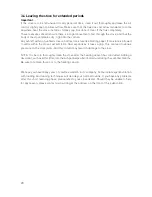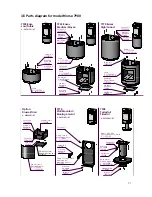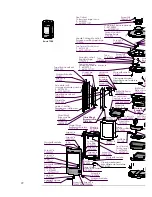
12
The secondary air is injected into the flue gases above the fire resulting in a cleaner, more efficient
combustion process. The supply of secondary air and Pilot air is fixed open and is not adjustable.
For extra safety, your stove should be with a removable handle.
2.2 Lighting and loading intervals
When first lighting the stove, a large volume of air is needed. When the stove is cold, you should
leave the door open an inch or two for the first few minutes and open the primary air supply
completely. While the door is open, do not leave the stove unattended.
To form a reasonable bed of ash on the floor of the stove, you should use 3-5 pounds of dry kindling
at the initial lighting. If possible, maintain a 1-1.5 inch (2-3 cm) layer of ash on the floor of the
combustion chamber for added insulation.
CAUTION
Do not place fuel within the installation clearances for the stove or within the
space required for loading fuel and ash removal.
Starting the First Fire
The initial fire should be small, so that the stove paint can cure and the main plates of the
stove can settle into position. Some fumes will be given off by the paint. Ventilate the room
during this phase.
The setting of the air control, lighting techniques and loading intervals will depend on chimney
draft, the fuel used, the heat required and so on. Some basic techniques are outlined below
.
In principle
Your stove should be with Primary and Secondary air and Pilot air inlets.
Primary Air is controlled using the lever situated over the door. Moving the control lever to right
position will open the air inlet and will allow a supply of preheated air to enter the firebox via the
‘airwash’ system situated inside the stove and above the glass.
Choosing your fuel
All types of natural wood can be burned on your stove, but they must be well seasoned and dry.
Once the wood is cut to length, it should be split down middle - to suit the dimentions given below
-to allowmoisture to evaporate.
Cut the wood to a length of max 12 inches (30 cm) and approx. 3 to 3.5 inches (7-8 cm) in section.
If you can weigh your wood, aim for around 2 lbs. For correct combustion and heat output, wood
fuel should contain no more than 20% moisture; this can easily be checked by using the Morsø
Moisture Meter (part # 62929900)
To naturally season wood fuel, stack and store it under cover in an airy location where fresh air
can move through each piece. Some soft woods may take as little as one good summer to season
whereas harder woods such as oak, maple, and elm may require seasoning up to 18 months.
Avoid overly dry wood that is gray in color as under certain conditions it can cause performance
problems, such as back-puffing and sluggishness. Well seasoned wood will be light to hold and
will show signs of cracking from the center-out in the ends. If your wood spits or sizzles when
b urnt, and your stove’s door glass persistently mists up, your wood is not properly seasoned.
Never use drift wood (from the sea), whose salt content may cause corrosion, nor construction
wood that may have been impregnated with chemicals.
Summary of Contents for 7943
Page 7: ...7 ...










































